Walking to Isaac Newton in Westminster Abbey
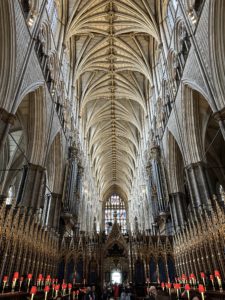
Pic 1. Quire of Westminster Abbey
1, From Pyx Chamber to Abbey’s West Towers
Located next to Houses of Parliament (with Big Ben), Westminster Abbey is an architectural masterpiece of the 13th to 16th centuries. It has been the setting for every Coronation since 1066, a period since King Edward (later known as St Edward the Confessor, c. 1003–1066, son of Ethelred the Unready; king of England 1042–1066) started to establish his royal palace by the banks of the river Thames in 1040s.
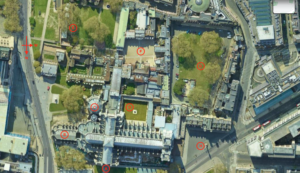
Pic 2. A Bird’s-eye view of Westminster Abbey (A: Entrance)
Edward’s Abbey survived for two centuries until the middle of the 13th century when King Henry III (1207–1272) decided to rebuild it in the new Gothic style of architecture. It was Henry III who translated the body of the saintly Edward the Confessor into a more magnificent tomb behind the High Altar (refer to the mark 5 in Pic 4) in his new church.
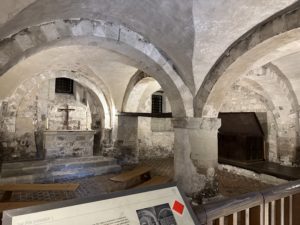
Pic 3. Pyx Chamber: one of the oldest surviving parts of the Abbey
Every monarch since William the Conqueror (c. 1027 – 1087) has been crowned in the Abbey, except for Edward V (1470 – c. 1483) and Edward VIII (1894–1972, who abdicated, and his brother became George VI in 1936) who were never crowned. The ancient Coronation Chair can still be seen in the church today (refer to the location in Pic 4).
There are around 3,300 burials in the church and cloisters along with many more memorials. One of the burials is the Unknown Warrior (refer to Pic 5), whose grave, close to the west door, has become a place of pilgrimage.
One notable new addition to the Abbey was the glorious Lady chapel built by King Henry VII (1457–1509), first Tudor king, which (Henry VII’s Lady chapel, refer to the location in Pic 4) now bears his name. Since 1725 it has been associated with the Most Honorable Order of the Bath and the banners of the current Knights Grand Cross surround the walls. The Battle of Britain memorial window by Hugh Easton (1906 – 1965) can be seen at the east end in the Royal Air Force chapel (“RAF chapel”, refer to the mark 13 in Pic 4).
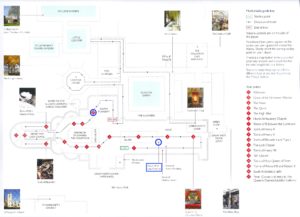
Pic 4. Self-guided Tour Map of Westminster Abbey
Two centuries later a further addition was made to the Abbey when the western towers (“The Abbey’s West Towers”, Unfinished from medieval times) were completed in 1745, to a design by Nicholas Hawksmoor (c. 1661 – 1736).
2, Scientists’ Corner: Newton Monument
When Henry III died in 1272, his magnificent new Gothic Abbey was not complete yet and so it remained attached to the old Norman nave until the building work could begin again in 1376. The present Nave was built nearly 150 years and was finally completed in 1517.
The Nave is at the western end of the Abbey and contains the graves and memorials of many famous people.
When looking east from Grave of the Unknown Warrior (Pic 5), to commemorate the many thousands killed in the 1914-1918, the decorated screen leading into the Quire includes a monument to Sir Isaac Newton (1642 – 1727).
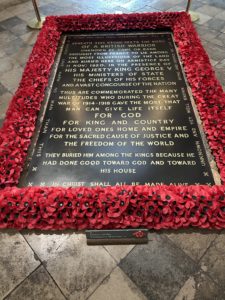
Pic 5. Grave of the Unknown Warrior
Newton was born at Woolsthorpe[1] in the parish of Colsterworth, Lincolnshire on Christmas Day 1642 (that is a date noting with Old Style), and was educated in Grantham and then at Trinity College Cambridge.
Newton became a Fellow of Trinity in 1667 and was Lucasian Professor from 1669 to 1702. Elected a Fellow of the Royal Society in 1672, Newton served as its President from 1705 to 1727. He became Master of the Mint in 1699 and was knighted in April 1705.
Newton died at Kensington on March 20th, 1727 and was buried in Westminster Abbey on March 28th.
It’s said that Voltaire (1694 – 1778) may have been present at Newton’s funeral.
Newton’s grave is in front of the choir screen, close to his monument that stands in the nave (against the choir screen) to the north of the entrance to the choir.
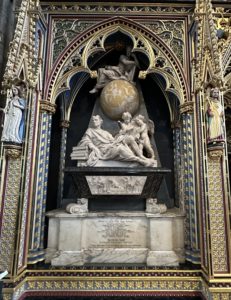
Pic 6. Newton Monument
The Latin inscription on ground reads (in English):
Here lies that which was mortal of Isaac Newton.
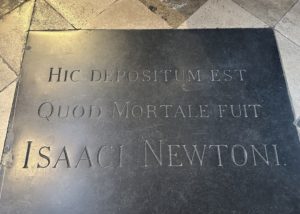
Pic 7. Latin Inscription on the ground of Newton’s Grave
The monument is made of white and grey marble by the sculptor Michael Rysbrack (1694-1770) to the designs of the architect William Kent (1685-1748). Its base has a Latin inscription and supports a sarcophagus with large scroll feet and a relief panel.
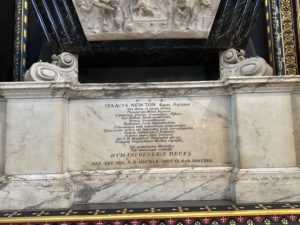
Pic 8. Newton Monument: Sarcophagus (Lower) and Relief (Upper)
The relief depicts boys using instruments related to Newton’s mathematical and optical work.
The Latin inscription on the sarcophagus reads (in English):
Here is buried Isaac Newton, Knight, who by a strength of mind almost divine, and mathematical principles peculiarly his own, explored the course and figures of the planets, the paths of comets, the tides of the sea, the dissimilarities in rays of light, and, what no other scholar has previously imagined, the properties of the colors thus produced. Diligent, sagacious and faithful, in his expositions of nature, antiquity and the holy Scriptures, he vindicated by his philosophy the majesty of God mighty and good, and expressed the simplicity of the Gospel in his manners. Mortals rejoice that there has existed such and so great an ornament of the human race! He was born on 25th December 1642, and died on 20th March 1726[2].
Above the sarcophagus is a reclining figure of Newton, in classical costume, with his right elbow resting on several books representing his great works. He points his left hand to a scroll with a mathematical design held by two standing winged boys.
The background is a pyramid on which there is a celestial globe with the signs of the Zodiac, of the constellations, and with the path of the comet of 1680[3]. On top of the globe sits a figure of Urania (the muse of Astronomy) leaning upon a book.
The poet Alexander Pope (1688 – 1744) had written an epitaph for Newton but this was not allowed to be put on the monument in the Abbey:
Nature and Nature’s laws lay hid in night: God said, Let Newton be! and all was light.
Some other scientists can also be found rest here near Isaac Newton.
Charles Darwin (1809 – 1882) was buried in 1882. William Thomas Kelvin (1824 – 1907, Lord Kelvin) was buried in 1907. Stephen Hawking (1942 – 2018) is another British scientist, whose ashes were buried nearby in 2018.
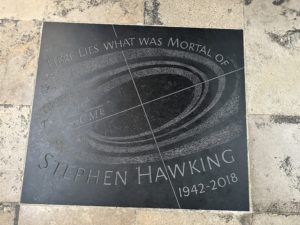
Pic 9. Stephen Hawking (1942-2018)
Other prominent scientists are commemorated with memorial plaques near these graves in this “Scientists’ Corner”, sometimes with the Latin inscription ‘Alibi Sepulti’ (“Buried elsewhere”), such as Michael Faraday (1791 – 1867) whose grave is located at Highgate Cemetery, London; and James Clerk Maxwell (1831 – 1879), who was buried at Parton Kirkcudbrightshire near Castle Douglas (Maxwell was born in Edinburgh, Scotland).
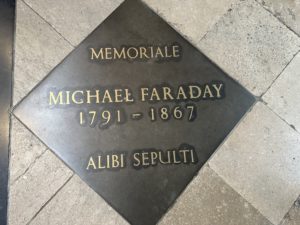
Pic 10. Michael Faraday’s memorial plaque
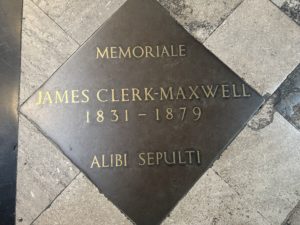
Pic 11. Memorial plaque of James Clerk Maxwell
-END-
Note:
1, Woolsthorpe Manor in Woolsthorpe-by-Colsterworth, near Grantham, Lincolnshire, England, is the birthplace and was the family home of Sir Isaac Newton.
2, The date of death is given in contemporary Old Style (“O.S.”) dating (The Julian calendar was in general use in Europe and northern Africa until 1582, when Pope Gregory XIII, 1502-1585, promulgated the Gregorian calendar), which in present dating is 1727.
3, Great Comet of 1680, aka Kirch’s Comet, and Newton’s Comet, was the first comet discovered by telescope (Gottfried Kirch, 1639 – 1710).
Declaimer: Pic 2 is an edited screenshot of Google map, while Pic 4 is an edited version of the scanned page of Westminster Abbey pamphlet. And some background knowledge in this writing comes from the official site of westminster-abbey.org.
